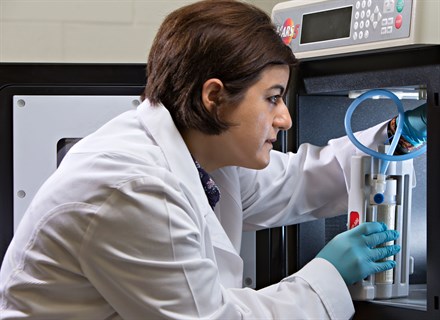Research to reduce airborne contaminants exposure
“A breath of fresh air” is a common saying, used to signify something cleansing and refreshing. But what if that air isn’t as clean as you think? In fact, what one researcher with the Zachry Department of Civil Engineering at Texas A&M University has found in the air may surprise you. Even more surprising are the applications of this finding, and how it can improve our lives.
“That Saharan dust pollutes Texas’ air was a completely serendipitous finding while investigating the amount of man-made, locally-sourced pollutants,” said Dr. Shankar Chellam, professor in the civil engineering department and faculty lead for the Aerosols & Water Treatment Lab. “When we think pollution in urban areas like Houston, we are programmed to place full blame on industry when really there are other unexpected, natural factors. This research can be used to adjust and regulate man-made pollutants in order to increase our quality of air.”
The average person breathes over 3,000 gallons of air each day, and breathing contaminated air can lead to a wealth of health issues ranging from irritated eyes to cancer, depending on the fine particles floating around. Reducing air pollution became a priority of the government in 1970 with the creation of the Environmental Protection Agency, which makes it its business to clean up air pollution in the country along with industry, local and state government and environmental groups.
Ongoing research at Texas A&M joins in this battle against an unseen enemy, choosing to focus on finding the myriad sources of fine particles in ambient air that we breathe. We want to know what the various sources are and what the particles are made of, that way someone else can take the findings and create policies and take action.
Key problems the team targets include the long-range transport of mineral dust from the Sahara and Middle East deserts and its impact on air quality in urban areas; particulate matter emissions from light-duty vehicles; and particle releases from petroleum refining operations.

“Pollution can be transported all over; it’s a mixed media that spreads and affects all,” said Ayse Bozlaker, a postdoctoral researcher working with Chellam. “We saw the need to quantify pollution caused by natural sources, something we cannot control, thus helping us to regulate man-made pollution and clean up our overall air quality.”
Expecting pollution to emanate from oil refineries and motor vehicles, two of the common sources of pollution in major metropolitan areas of Texas, the researchers developed unique metal signatures for various industrial and natural sources of aerosols, and then collected samples from different locations and determined whether there were signatures of various sources in the these samples.
Through their efforts, it is now possible to isolate, identify and quantify petroleum refinery, vehicular and desert dust impacts on urban air quality. This was achieved through developing novel analytical techniques to measure platinum, palladium, rhodium and rare earth elements, along with a wide range of other metals in the atmosphere.
Applications from this research could play a vital role in regulating air quality, impacting large industries all the way down to vehicle users. The findings can be used for the objective measurement of industrial and natural particulate emissions and the development of better science-based policies or regulations.
For more information, visit the Aerosols & Water Treatment Lab website.